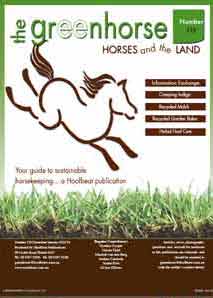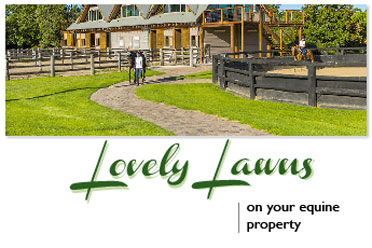The Green Horse section provides practical information on managing environmentally sustainable horse properties, readers stories and tips, as well as advice and articles from equestrian experts in their fields.
April May 21
Vol 42 No 6
In this issue of The Green Horse you will find the following articles
Trees For Fodder and Treats
by Celine Bønnelykke
In part 1 of the series on ‘Trees on the property’ the importance of trees in regards to shade, shelter, wind and soil erosion was determined. But trees can have even more benefits for your horses, especially where pasture is scarce.
Weed Watch – Tropical Apple Soda
Described as the ‘weed from hell’, one can only imagine the devastation this weed can cause to property and landowners.
Deeds, Steeds and Weeds
Mice plagues, Seaweed snacks and Anthrax.
Lovely Lawns on Your Equine Property
by Rhiannon Brown
Hidden Danger in our Horse’s Water by Liz Tollarzo
With the average horse drinking around 30 – 50 litres per day - which of course increases in warmer weather or if exercised hard – fresh, clean water is an important requirement that should be readily available at all times to keep a horse healthy.
WIN A YEAR'S SUBSCRIPTION...
share your equine property management tips and each issue one reader will win.
Send ideas to -
The Green Horse Support <greenhorse@hoofbeats.com.au>


PREVIOUS ARTICLES
Available on line
Feb/March 21
STABLE DANGERS
by Elizabeth Tollarzo
They say that horses are accidents-waiting-to-happen as they are inclined to find every conceivable way to injur themselves, usually just before a competition. Being aware of potential dangers in the stable - and addressing these - may help aleiviate injury.
Dec/Jan 20/21
HORSES AND HONEY BEES-
Can they share space on the property?
by Wendy Elks
Oct/Nov 20
SOLAR-POWERED PRODUCTS
by Celine Bønnelykke
In previous issues we have discussed the economics of setting up a solar-driven property, but if finances don’t stretch to installation of the whole package, there are ways to ease into the solar-world.
Aug/Sept 20 THE HIDDEN DANGERS IN OUR PADDOCK.
by Elizabeth Tollarzo
Horses love to run, play, buck and then run again and we often, through lack of risk assessment or management practices, place them in areas that are fraught with dangers.
JUNE JULY 20 GOING SOLAR ON THE HORSE PROPERTY Where to put your panels Part 2
Once you have selected what solar system best suits your needs, then you need to look at how you can maximise the advantages.
APRIL MAY 20 GOING SOLAR ON THE HORSE PROPERTY Part 2
Once you have selected what solar system best suits your needs, then you need to look at how you can maximise the advantages.
FEB/MARCH 20 ANTS AWAY
by Mark Brown Envirapest
So, what can you do to deter ants from your house and your stables??
DJ19/20 KEEPING SNAKES OUT OF THE STABLE by Wendy Elks
Snakes may be protected under Wildlife regulations in Australia, and they may be great for keeping the mice and rats down, but do we want to find them in our stables near our horses and pets?
ON19 - TERMITES- common myths
by Rhiannon Brown, Envirapest
Your house and stables are looking wonderful this spring, but do you know what is happening inside the walls of your brick or timber building?
AS19 - OUCH THAT HURTS
by Catherine Bird for Country Park Saddlery
The extent of the swelling is usually an indication of the severity of the infection or injury and the cause needs to be established before giving herbs.
JJ19 - MANAGING PASTURE
by Rhiannon Brown, Envirapest Healthy pasture means healthy horses.
A/M19 - STOP THOSE WEEDS
Property biosecurity
by Rhiannon Brown, Envirapest
Putting simple precautionary steps into place can make it tough for weeds to get a hold on your equine paradise.
|
  
  


by Rhiannon Brown - Envirapest
On a horse property there always seems to be acres of grass, but we all have that little bit of lawn we want to look luscious all year round.
It could be the entrance to the stables, laneways bordering the driveway, that little ‘special’ snack paddock or you could even dream of a beautiful green arena.
LOVELY LAWNS
Where to start? There are so many products and so much information available that the whole thing can seem overwhelming. So, we thought April was a great time to give you a bit of lawn insight so you can create and maintain that beautiful green lawn of your dreams.
TURNING GRASS INTO LAWN
It’s simple really, as your grass only needs three things to look like a good and healthy lawn – frequent mowing, 10mm of water a few times a week and a good fertiliser and wetter plan.
Cutting Your Lawn
The more your lawn area is mowed, the healthier it will be. If grass is long then you should only reduce it by one third of the leaf height each mowing to avoid stressing the grass. Really – you can’t mow too much as long as you don’t cut too low. You really want to take off the tip of the leaf regularly, which encourages growth. If you do mow and the lawn yellows off, it means you have mowed a little short. But don’t be discouraged – stay with the plan and it will come back nicely.
Mowing when the lawn is wet can cause clumping and uneven cutting so the ideal time to mow is mid morning - the dew has gone but the heat should not cause stress.
Growth can be affected by soil conditions, type of grass, regular or irregular watering habits and of course, rainfall will encourage quicker growth.
The height of your lawn depends on the grass type but a rough guide is: Kikuyu 30 – 50mm, Couch 10 – 30mm, Soft Leaf Buffalo 30 – 50mm. You should do a test patch or two to see what works best on your property.
Water, Water, Water
Like with all plants, water is especially important in keeping your lawn on point. You could be doing everything right but if you are not getting enough water onto the lawn it will take longer to recover from damage. It also leaves it more vulnerable to weeds establishing and pests taking up residence. This doesn’t mean you have to water every day and need to send your self bankrupt in the process.
The key is making sure the lawn is watered regularly. You will want between 20 to 30mls per week, so divide this between your allocated watering days. A general rule is under 30 degrees – 20mls. When it is consistently over 30 degrees, increase your watering time to achieve 30mls per week. Check your sprinklers regularly and use catch cups (easily found online or at gardening stores), placed around the lawn to check that all the lawn areas are getting the required water. They will make it easy to measure and determine how long you need to run your retic for to achieve the right amount of water to keep a healthy green lawn all summer.
If you have a solid reticulation system with pop up sprinklers you should only need to be running your sprinklers for about 15 minutes to achieve the right amount of watering. The magical time to have the sprinklers turn on is as the sun is rising – this will help with evaporation and give your lawn a great start to the day.
Feeding Your Lawn
Applying a granular fertiliser to your lawn every three months will bring it to life. You should be aware that, like with most things, you get what you pay for. We would also recommend investing in a hand spreader so that you get the even spread over the lawn. The most important thing to remember is to water it in, at least 6mm of water should be applied after fertilisation and no mowing for 24 hours.
A soil wetter should also be applied during the watering months. This is particularly important with hydrophobic soils like the sandy soil in WA. If you have a patchy lawn despite mowing, watering and fertilising you may need to think about applying a wetting agent. Wetting agents attract the water into the soil and improve the water run off – meaning your lawn will grow deeper roots. By improving the soil, you will be saving water and ensuring it gets to wherever it is needed.
Most importantly though, you should ENJOY your lawn. A good lawn is supposed to be used, not just admired from a distance. Don’t be afraid to put the trampoline on the back lawn – just move it regularly.
With a little maintenance it won’t be long before your grass looks like a bowling green.

|